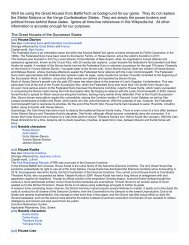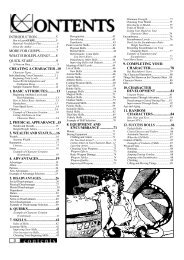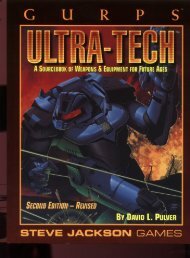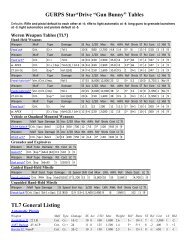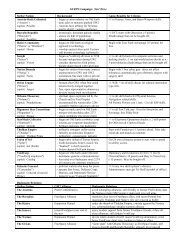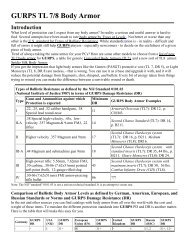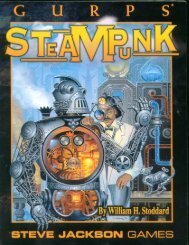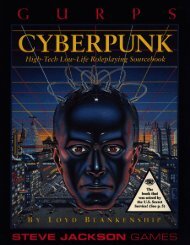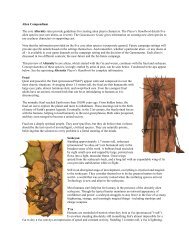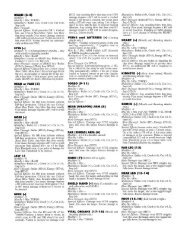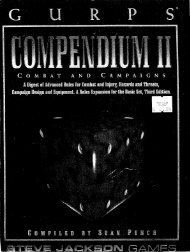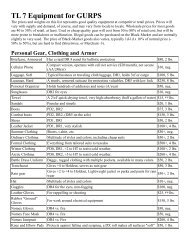GURPS - Compendium 1..
GURPS - Compendium 1..
GURPS - Compendium 1..
Create successful ePaper yourself
Turn your PDF publications into a flip-book with our unique Google optimized e-Paper software.
No Physical Body<br />
-100 points<br />
You have no limbs, sense organs, cardiovascular or gastrointestinal<br />
systems, etc. You are a disembodied brain, and all sensory<br />
input must be provided through psi abilities or hard-wired in.<br />
Your brain tissue must be supported by an artificial nutrient<br />
system. This costs $250,000, plus $10,000/month in maintenance<br />
at TL8 (halve costs at TL9 and again at TL 10). Weight is<br />
200 pounds and volume 0.2 cubic yards. If such a system exists in<br />
a late TL7 world, increase space, cost and weight by a factor of<br />
ten or more.<br />
You have no Strength attribute; you do have a Dexterity<br />
attribute which comes into play if you learn a Physical skill,<br />
such as Driving, for exercise by remote control. Your physical<br />
brain has a HT attribute (for rolls against shock, etc.) but one<br />
point of actual damage will render you unconscious and two or<br />
more points will kill you. Your life support system may have<br />
armor, however.<br />
Although you have no Strength, you have Fatigue points<br />
equal to your IQ - these are used to calculate Fatigue loss from<br />
magic or psi abilities or attacks such as Mental Blow, and to<br />
measure psychic stress. Recovery rules apply normally.<br />
You have no glands, and therefore you feel no strong emotions.<br />
Lust, bloodlust, terror and excitement ... all are lost to<br />
you. You make all Fright Checks at +5, and ignore any physical<br />
result of a failed Fright Check (read down the chart to the first<br />
applicable mental result). You can still feel intellectual emotions,<br />
like reasonable fear, cold hatred, friendship and greed.<br />
Squeamish people and necrophobes<br />
must make Fright<br />
Checks when seeing you; they<br />
must check at +2 if they just talk to<br />
you on the telephone or via<br />
telepathy, if they know or guess<br />
what you are. Most strangers,<br />
except doctors, react to you at -1<br />
when meeting you in person.<br />
You may have any kind of psi<br />
abilities (making you a "psiborg"),<br />
and may be attached to<br />
any kind of psionic device that<br />
can use a psiberface system. Psi<br />
drugs may be rigged to drip into<br />
your nutrient fluid, wit h normal<br />
effects. Through telepathy, you<br />
could come to experience another's<br />
emotions or see through<br />
their minds. Astral Projection<br />
could give you a kind of mobility.<br />
It would be up to the GM<br />
whether your astral form is the<br />
body you had (if any) or that of a<br />
brain (with or without an image of<br />
the life support system).<br />
If the cybernetic technology is<br />
up to it, you may possess an<br />
interface jack that enables you to be<br />
hooked up to computers, voice<br />
synthesizers, sensors,<br />
communication systems, or the<br />
like - see <strong>GURPS</strong> Cyberpunk and<br />
Ultra-Tech.<br />
Prefrontal Lobotomy - 15<br />
points<br />
This is treated as a mental disadvantage; see p. 93.<br />
Quadriplegic<br />
-50 points<br />
You are paralyzed in both arms and both legs, or possibly<br />
you lack limbs entirely - you can't move without assistance. If<br />
you have cybernetic replacement limbs, you can't have this disadvantage!<br />
A quadriplegic may start with a DX and ST of 6<br />
without this counting against his disadvantage total - anything<br />
below this counts, however. (For instance, the point difference<br />
between DX 5 and DX 6 is 10 points, so DX 5 would count as -<br />
10 points of disadvantage.)<br />
Quadriplegics can be good netrunners (with the appropriate<br />
voice-controlled equipment), mages (with high enough skill) or<br />
psis. Such characters may have the Delusion that cyberspace,<br />
the astral plane or some other realm that their abilities allow<br />
them to visit is the only "reality," and will never willingly leave!<br />
Reduced Hit Points<br />
-5 points/level<br />
In a realistic campaign, the GM may wish to limit characters to<br />
a certain number of Reduced Hit Points; three or four levels are<br />
reasonable.<br />
You can take less damage than a normal human of your HT.<br />
Hit Points are initially equal to HT, so a character with HT 12<br />
could lower his Hit Point total to<br />
10 as a -10-point disadvantage.<br />
This would be written as HT<br />
12/10. All rolls versus HT are<br />
still made against his health of 12.<br />
Only damage is subtracted from 10.<br />
Very small races often have<br />
this disadvantage.<br />
If the Stun Damage optional<br />
rule is in effect, Stun is based on<br />
hit points, not basic HT.<br />
See <strong>Compendium</strong> II, pp.<br />
152-154, for special rules that<br />
apply to characters whose HT is<br />
not equal to their Hit Points.<br />
Reduced Manual<br />
Dexterity<br />
-3 points/level<br />
Each level of this disadvantage<br />
gives you a -1 to DX, or IQ in<br />
some cases, but only on tasks<br />
requiring fine motor skills. This<br />
skill would hinder an attempt to<br />
repair a watch, for example, but<br />
not Combat/Weapon skills or<br />
Dodge.<br />
Reduced Move<br />
-5 points/point of<br />
Move<br />
At the GM's option, this disadvantage<br />
may be permitted<br />
even in realistic campaigns to<br />
represent "generic" disorders<br />
that affect the legs. See p. 103.<br />
83




